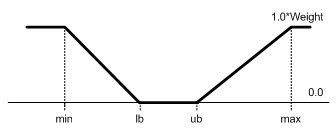First time here? Check out the Help page!
 | 1 | initial version |
Ivan's still enjoying sun and sea on a Greek island, I believe :-D
Constraint functions are used to test whether a solution is 'feasible' or not. You may consider them as a special type of objectives, whose values must fall within a range, [lb, ub], defined by the user. Normally you would need to enable 'scaling' in the constraint definition, unless your feasible range is <=0. The use of the five scaling parameters (lb, ub, min, max, and weight) is best illustrated in the diagram below. The algorithm considers 0 and below as feasible, and anything above 0 as unfeasible. It works to minimize the sum of the constraint values if more than on constraint are defined.

